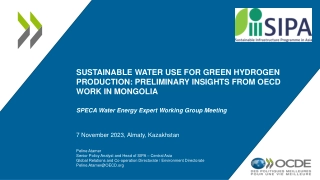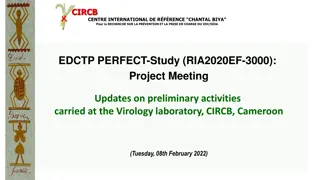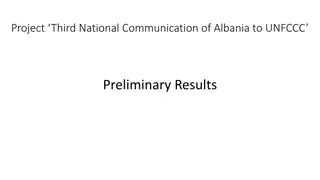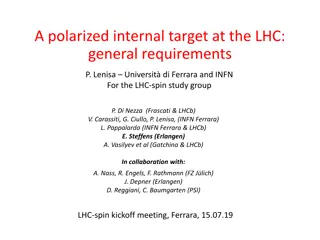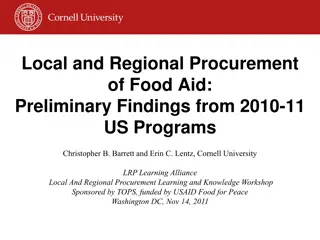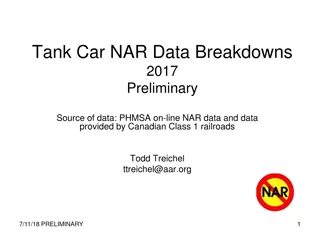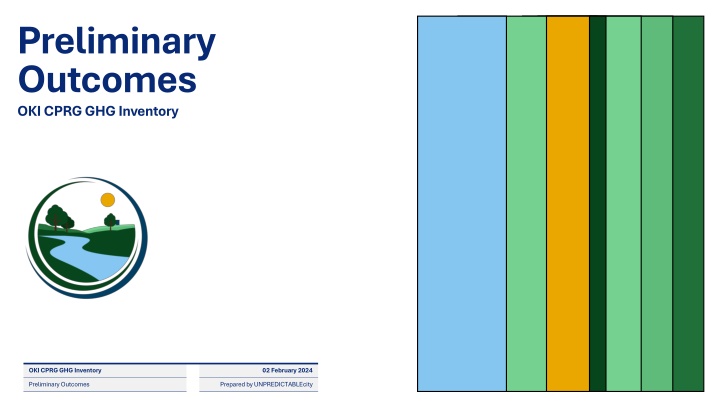
Preliminary Outcomes
This document presents the preliminary outcomes of the OKI CPRG GHG Inventory conducted on 02 February 2024, detailing the methodology used for data collection and analysis. The inventory includes energy consumption estimates, waste emissions data, and methodology for analyzing various sectors. Local data integration and standard emission rates play a crucial role in producing these outcomes.
Download Presentation

Please find below an Image/Link to download the presentation.
The content on the website is provided AS IS for your information and personal use only. It may not be sold, licensed, or shared on other websites without obtaining consent from the author. If you encounter any issues during the download, it is possible that the publisher has removed the file from their server.
You are allowed to download the files provided on this website for personal or commercial use, subject to the condition that they are used lawfully. All files are the property of their respective owners.
The content on the website is provided AS IS for your information and personal use only. It may not be sold, licensed, or shared on other websites without obtaining consent from the author.
E N D
Presentation Transcript
Preliminary Outcomes OKI CPRG GHG Inventory OKI CPRG GHG Inventory 02 February 2024 Preliminary Outcomes Prepared by UNPREDICTABLEcity
OKI CPRG GHG Inventory Preliminary Outcomes 02 February 2024 Agenda Slide 2 Today s Agenda 1. Methodology 2. Regional Results Review 3. Areas to be Developed
OKI CPRG GHG Inventory Preliminary Outcomes 02 February 2024 Methodology Slide 3 Methodology Overview Generally, state level data are downscaled to the county and census tract levels based on additional data to produce an estimate of energy consumption. Local data provided by the utilities are integrated whenever possible to improve estimates. Energy data are then multiplied by standard emission rates to produce the inventory. Local Data Duke Municipal Utilities x = Emission Factors US EPA AR5 Federal Data Census US EIA US EPA US BTS FEMA Emissions Estimates State Level Energy Data US EIA Residential Commercial Industrial Transportation
OKI CPRG GHG Inventory Preliminary Outcomes 02 February 2024 Methodology Slide 4 Methodology Overview Waste emissions are taken directly from US EPA s Greenhouse Gas Reporting Program. Wastewater emissions are developed by taking treatment plant information provided by OKI, estimating water service by county, and using US EPA s Local Greenhouse Gas Inventory Tool to estimate emissions. Emissions Directly from US EPA GHGRP Waste = Local Data OKI Google Earth LGGIT US EPA Emissions Estimates Wastewater
OKI CPRG GHG Inventory Preliminary Outcomes 02 February 2024 Methodology Slide 5 Methodology Includes EIA FORM-861 Data? Analysis Source Sector Category Emission Source Data Sources Includes Duke Data? US EIA SEDS US Census US EIA RECS US EIA Form 861 Utility Data Electricity Residential Buildings and Equipment Electricity Yes, when Duke is the sole IOU provider within the county. Otherwise used for validation. Yes, if the county contains a municipal utility and is supplied by Duke outside of the municipal territory. Otherwise used for validation. Electricity Commercial Buildings and Equipment Electricity US EIA SEDS FEMA Building Data US EIA CBECS US EIA Form 861 Utility Data Yes, when Duke is the sole IOU provider within the county. Otherwise used for validation. Yes, if the county contains a municipal utility and is supplied by Duke outside of the municipal territory. Otherwise used for validation. Electricity Industrial Buildings and Equipment Electricity US EIA SEDS FEMA Building Data US EIA MECS US EIA Form 861 Only used for validation. Only used for validation.
OKI CPRG GHG Inventory Preliminary Outcomes 02 February 2024 Methodology Slide 6 Methodology Analysis Source Sector Category Emission Source Data Sources Includes Duke Data? Stationary Combustion Residential Buildings and Equipment Natural Gas US EIA SEDS US Census US EIA RECS Utility Data Yes, when Duke is the sole provider within the county. Otherwise used for validation. All Other Fuels US EIA SEDS US Census US EIA RECS No Stationary Combustion Commercial Buildings and Equipment Natural Gas US EIA SEDS FEMA Building Data US EIA CBECS Utility Data Yes, when Duke is the sole provider within the county. Otherwise used for validation. All Other Fuels US EIA SEDS FEMA Building Data US EIA CBECS No Stationary Combustion Industrial Buildings and Equipment All Fuels US EIA SEDS FEMA Building Data US EIA MECS US EPA GHGRP No
OKI CPRG GHG Inventory Preliminary Outcomes 02 February 2024 Methodology Slide 7 Methodology Analysis Source Sector Category Emission Source Data Sources Waste Commercial Landfills Waste Process Emissions US EPA GHGRP Wastewater Commercial Wastewater Treatment Wastewater Process Emissions OKI Google Earth US EPA LGGIT Off Road Mobile Combustion Commercial Transportation Air All US EIA SEDS US BTS Rail All US EIA SEDS US BTS Maritime All US EIA SEDS US BTS On Road Mobile Combustion All All All US EPA NEI 2020 US EIA SEDS
OKI CPRG GHG Inventory Preliminary Outcomes 02 February 2024 Emissions by Sector Slide 8 OKI Region 2022 Emissions by Sector MT CO2e Overview 2022 emissions for the region total 43.8 million metric tons of carbon dioxide equivalents (MT CO2e). This equates to roughly 19.5 MT CO2e per capita for the region. As a reference, in 2021 the average per capita emissions for the entire US is 19.1 MT CO2e (although this varies widely by state). 18,000,000 15,369,534 16,000,000 14,000,000 13,145,582 12,000,000 As a percent of total: Industrial = 35% Transportation = 30% Residential = 19% Commercial = 16% 10,000,000 8,350,108 8,000,000 6,979,906 6,000,000 Points of Note The transportation sector includes emissions from residential, commercial, and industrial sector activities. The commercial sector includes waste and wastewater treatment. Process emissions from the agricultural sector have not been included yet. These values are considered gross emissions and do not include any offsets or carbon credit mechanisms. 4,000,000 2,000,000 0 Industrial Transportation Residential Commercial
OKI CPRG GHG Inventory Preliminary Outcomes 02 February 2024 Emissions by Analysis Sector Slide 9 OKI Region 2022 Emissions by Analysis Sector MT CO2e Overview The Analysis Sectors are categories used by the US EPA. In the OKI region, emissions are largely driven by fuel burned on site. 18,000,000 16,512,824 16,000,000 As a percent of total: Stationary Combustion = 38% Electricity = 30% Mobile Combustion = 30% Waste = 2% Wastewater = 1% 14,000,000 13,185,117 13,145,582 12,000,000 10,000,000 8,000,000 Points of Note Electricity includes a grid-level line loss rate of 4.5%. Fugitive emissions, such as from natural gas, have not been included. These values are considered gross emissions and do not include any offsets or carbon credit mechanisms. 6,000,000 4,000,000 2,000,000 674,929 326,678 0 Stationary Combustion Electricity Mobile Combustion Waste Wastewater
OKI CPRG GHG Inventory Preliminary Outcomes 02 February 2024 Emissions by Sub-Category Slide 10 OKI Region Emissions by Sub-Category Overview Buildings and equipment are the largest source of emissions based on their subcategory, primarily driven by electricity and natural gas consumption. Air includes in-boundary emissions (scope 1), as well as out-of-boundary (scope 3) emissions that occur from flights originating from or arriving at airports in the region. Maritime 8,850 Refuse Trucks 29,817 Buses 99,477 Rail 145,985 As a percent of total: Buildings and Equipment = 68% Personal Vehicles = 15% Commercial Vehicles = 8% Air = 7% Landfills = 2% Wastewater Treatment = 1% Rail = 0.3% Buses = 0.2% Refuse Trucks = 0.07% Maritime = 0.02% Wastewater Treatment 326,678 Landfills 674,929 Air 2,854,521 Commercial Vehicles 3,345,556 Personal Vehicles 6,661,376 Buildings and Equipment 29,697,941 0 10,000,000 20,000,000 30,000,000 40,000,000 MT CO2e
OKI CPRG GHG Inventory Preliminary Outcomes 02 February 2024 Emissions by Source/Fuel Slide 11 OKI Region Emissions by Source/Fuel Municipal Solid Waste 81,571 Propane 291,010 Wastewater Process Emissions 326,678 Overview Fuels used in buildings and transportation are the main contributors to the region s emissions. Other Fuels is primarily composed of various industrial fuels. Waste Process Emissions 674,929 Coal 1,233,578 Other Fuels 2,253,949 As a percent of total: Electricity = 30% Natural Gas = 17% Gasoline = 17% Industrial Gaseous Fuels = 10% Distillate Fuel Oils = 9% Jet Fuel = 7% Other Fuels = 5% Coal = 3% Waste Process Emissions = 2% Wastewater Process Emissions = 1% Propane = 0.7% Municipal Solid Waste (as fuel) = 0.2% Jet Fuel 2,850,624 Distillate Fuel Oils 3,774,843 Industrial Gaseous Fuels 4,403,491 Gasoline 7,375,259 Natural Gas 7,394,080 Electricity 13,185,117 0 3,000,000 6,000,000 9,000,000 12,000,000 15,000,000 MT CO2e
OKI CPRG GHG Inventory Preliminary Outcomes 02 February 2024 Emissions by County and Sector Slide 12 OKI Region 2022 Emissions by County and Sector Overview 70% of the region s emissions are produced in 3 counties. The table below presents the percentage that each county contributes to the sector total, and for overall emissions. Ohio County Union County Bracken County Pendleton County Commercial Industrial Residential Transportation County Total 43% 30% 37% 17% 45% 17% 6% 7% 10% 4% 10% 6% 3% 3% 2% 2% 2% 2% 2% 5% 1% 1% 2% 1% 1% 1% 1% 2% 1% 1% 0% 0% 0% 0% 0% 100% 100% 100% Hamilton County Butler County Boone County Warren County Clermont County Kenton County Campbell County Dearborn County Brown County Gallatin County Grant County Franklin County Pendleton County Bracken County Union County Ohio County OKI Total 28% 10% 28% 8% 6% 6% 3% 3% 2% 1% 2% 1% 0% 0% 0% 0% 100% 33% 24% 13% 8% 6% 5% 3% 2% 2% 1% 1% 1% 1% 0% 0% 0% 100% Franklin County Grant County 6% Gallatin County 9% 8% 5% 2% 2% 0% 1% 1% 1% 0% 0% 0% Brown County Dearborn County Campbell County Residential Commercial Industrial Transportation Kenton County Clermont County Warren County Boone County Butler County Hamilton County 0 3,000,000 6,000,000 9,000,000 12,000,000 15,000,000 MT CO2e
OKI CPRG GHG Inventory Preliminary Outcomes 02 February 2024 Emissions by Source/Fuel Slide 13 Areas to be Developed Tree Canopy Carbon sequestration by the tree canopy will be estimated using iTREE and local land use data. (Will decrease emissions) Additional Transportation Information The MOVES model may be used to refine estimates in order to better align values with other regional activities (such as transportation planning). (Potential impact unknown) Agricultural Emissions Emissions from the agricultural sector will be estimated using the National Agricultural Census and state-level emissions and fertilizer data provided by US EPA. (Will increase emissions) RECS and Other Credit Mechanisms The impact of behind-the-meter solar (residential, commercial) is already accounted for within the analysis. However, the impact of power purchase agreements (PPAs) and solar projects that retain and retire renewable energy credits (RECs), can be included in the analysis. This will credit total emissions on a net-basis. (Will decrease emissions) Additional Waste and Wastewater Information More accurate data may be pursued and included for waste and wastewater operations. (Potential impact unknown) Fugitive Emissions Leaks in the transport and use of gaseous fuels are typically assumed to be 0.5% of total consumption. These values may be added into the analysis. (Will increase emissions)
Contact Jon-Paul d Aversa, AICP Principal UNPREDICTABLEcity e: jpdaversa@UNPREDICTABLE.city

